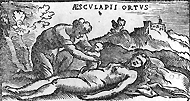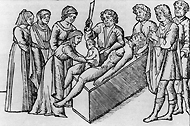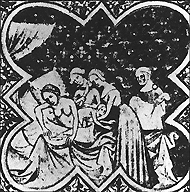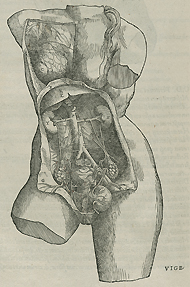Cesarean Section - A Brief History
Part 1
Cesarean section has been part of human culture since ancient times and there are tales in both Western and non-Western cultures of this procedure resulting in live mothers and offspring. According to Greek mythology Apollo removed Asclepius, founder of the famous cult of religious medicine, from his mother's abdomen. Numerous references to cesarean section appear in ancient Hindu, Egyptian, Grecian, Roman, and other European folklore. Ancient Chinese etchings depict the procedure on apparently living women. The Mischnagoth and Talmud prohibited primogeniture when twins were born by cesarean section and waived the purification rituals for women delivered by surgery.

The extraction of Asclepius from the abdomen of his mother Coronis by his father Apollo. Woodcut from the 1549 edition of Alessandro Beneditti's De Re Medica.
Yet, the early history of cesarean section remains shrouded in myth and is of dubious accuracy. Even the origin of "cesarean" has apparently been distorted over time. It is commonly believed to be derived from the surgical birth of Julius Caesar, however this seems unlikely since his mother Aurelia is reputed to have lived to hear of her son's invasion of Britain. At that time the procedure was performed only when the mother was dead or dying, as an attempt to save the child for a state wishing to increase its population. Roman law under Caesar decreed that all women who were so fated by childbirth must be cut open; hence, cesarean. Other possible Latin origins include the verb "caedare," meaning to cut, and the term "caesones" that was applied to infants born by postmortem operations. Ultimately, though, we cannot be sure of where or when the term cesarean was derived. Until the sixteenth and seventeenth centuries the procedure was known as cesarean operation. This began to change following the publication in 1598 of Jacques Guillimeau's book on midwifery in which he introduced the term "section." Increasingly thereafter "section" replaced "operation."

One of the earliest printed illustrations of Cesarean section. Purportedly the birth of Julius Caesar. A live infant being surgically removed from a dead woman. From Suetonius' Lives of the Twelve Caesars, 1506 woodcut.
During its evolution cesarean section has meant different things to different people at different times. The indications for it have changed dramatically from ancient to modern times. Despite rare references to the operation on living women, the initial purpose was essentially to retrieve the infant from a dead or dying mother; this was conducted either in the rather vain hope of saving the baby's life, or as commonly required by religious edicts, so the infant might be buried separately from the mother. Above all it was a measure of last resort, and the operation was not intended to preserve the mother's life. It was not until the nineteenth century that such a possibility really came within the grasp of the medical profession.

Cesarean section performed on a living woman by a female practitioner. Miniature from a fourteenth-century "Historie Ancienne."
There were, though, sporadic early reports of heroic efforts to save women's lives. While the Middle Ages have been largely viewed as a period of stagnation in science and medicine, some of the stories of cesarean section actually helped to develop and sustain hopes that the operation could ultimately be accomplished. Perhaps the first written record we have of a mother and baby surviving a cesarean section comes from Switzerland in 1500 when a sow gelder, Jacob Nufer, performed the operation on his wife. After several days in labor and help from thirteen midwives, the woman was unable to deliver her baby. Her desperate husband eventually gained permission from the local authorities to attempt a cesarean. The mother lived and subsequently gave birth normally to five children, including twins. The cesarean baby lived to be 77 years old. Since this story was not recorded until 82 years later historians question its accuracy. Similar skepticism might be applied to other early reports of abdominal delivery þ those performed by women on themselves and births resulting from attacks by horned livestock, during which the peritoneal cavity was ripped open.
The history of cesarean section can be understood best in the broader context of the history of childbirth and general medicine þ histories that also have been characterized by dramatic changes. Many of the earliest successful cesarean sections took place in remote rural areas lacking in medical staff and facilities. In the absence of strong medical communities, operations could be carried out without professional consultation. This meant that cesareans could be undertaken at an earlier stage in failing labor when the mother was not near death and the fetus was less distressed. Under these circumstances the chances of one or both surviving were greater. These operations were performed on kitchen tables and beds, without access to hospital facilities, and this was probably an advantage until the late nineteenth century. Surgery in hospitals was bedeviled by infections passed between patients, often by the unclean hands of medical attendants. These factors may help to explain such successes as Jacob Nufer's.
By dint of his work in animal husbandry, Nufer also possessed a modicum of anatomical knowledge. One of the first steps in performing any operation is understanding the organs and tissues involved, knowledge that was scarcely obtainable until the modern era. During the sixteenth and seventeenth centuries with the blossoming of the Renaissance, numerous works illustrated human anatomy in detail. Andreas Vesalius's monumental general anatomical text De Corporis Humani Fabrica, for example, published in 1543, depicts normal female genital and abdominal structures. In the eighteenth and early nineteenth centuries anatomists and surgeons substantially extended their knowledge of the normal and pathological anatomy of the human body. By the later 1800s, greater access to human cadavers and changing emphases in medical education permitted medical students to learn anatomy through personal dissection. This practical experience improved their understanding and better prepared them to undertake operations.
At the time, of course, this new type of medical education was still only available to men. With gathering momentum since the seventeenth century, female attendants had been demoted in the childbirth arena. In the early 1600s, the Chamberlen clan in England introduced obstetrical forceps to pull from the birth canal fetuses that otherwise might have been destroyed. Men's claims to authority over such instruments assisted them in establishing professional control over childbirth. Over the next three centuries or more, the male-midwife and obstetrician gradually wrested that control from the female midwife, thus diminishing her role.
Last Reviewed: March 6, 2024


